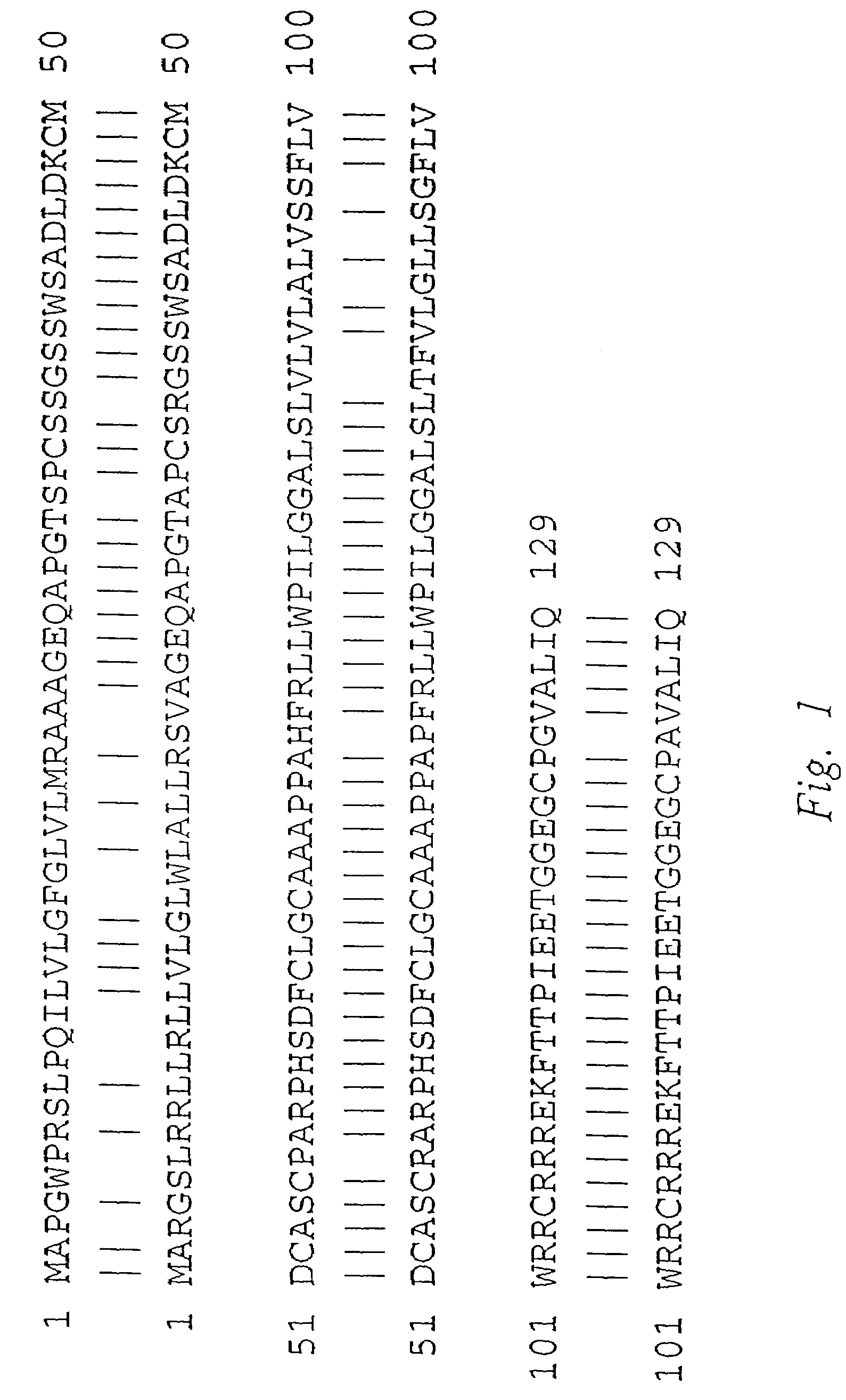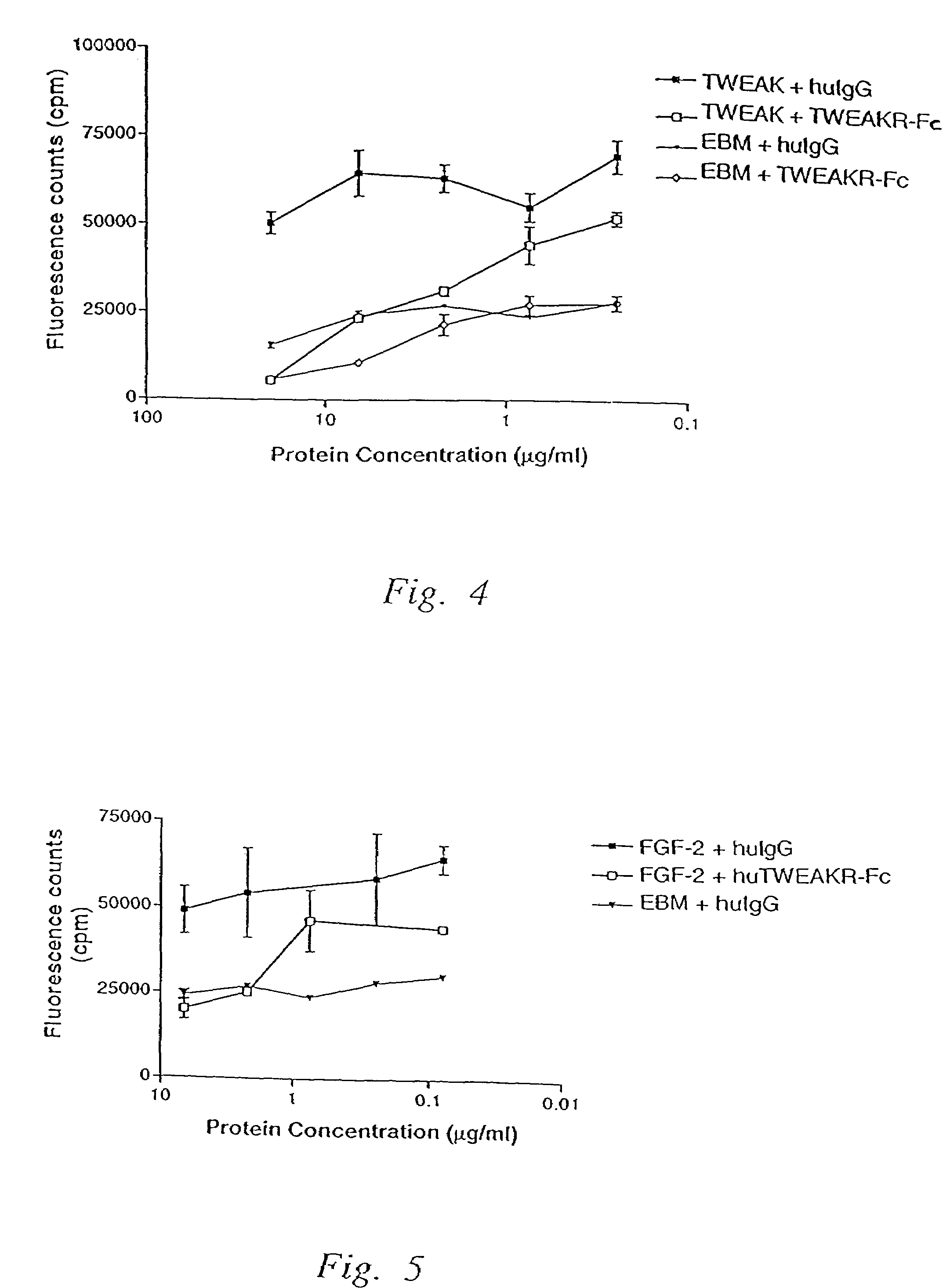Compositions and methods relating to multimeric and oligomeric soluble fragments of the TWEAK receptor
a technology of tweak receptor and soluble fragment, which is applied in the direction of drug compositions, peptides, cardiovascular disorders, etc., can solve problems such as pathological angiogenesis, and achieve the effect of better competition and higher binding affinity for tweak
- Summary
- Abstract
- Description
- Claims
- Application Information
AI Technical Summary
Benefits of technology
Problems solved by technology
Method used
Image
Examples
example 1
[0157]This example presents the cloning and identification of the TWEAK Receptor.
[0158]Expression Cloning of TWEAK Receptor cDNA
[0159]To clone TWEAK Receptor cDNA, an expression vector encoding a growth hormone leader, a leucine zipper multimerization domain, and the C-terminal extracellular domain of human TWEAK (see Chicheportiche et al., J. Biol. Chem. 272(51):32401, 1997) was constructed. This expression vector, which was named pDC409-LZ-TWEAK, comprised the DNA sequence SEQ ID NO:1 and encoded the polypeptide SEQ ID NO:2. pDC409-LZ-TWEAK conditioned supernatants were produced by transient transfection into CV1-EBNA cells. These supernatants were incubated with magnetic beads coated with polyclonal goat anti-mouse antibody that had previously been incubated with a mouse monoclonal antibody against the leucine zipper. Control beads were produced by mixing the coated beads with supernatants from cells transfected with empty vector.
[0160]A monolayer of COS cells grown in a T175 fla...
example 2
[0166]This example presents the recombinant production of soluble TWEAK Receptor Fc (TWEAKR-Fc) fusion polypeptides.
[0167]To construct a nucleic acid encoding the TWEAKR extracellular domain fused to Fc, a nucleic acid encoding the N-terminal 79 amino acids from TWEAKR, including the leader (signal peptide), was joined to a nucleic acid encoding an Fc portion from human IgG1. Sequences for this construct are shown as SEQ ID NO:6 (nucleic acid) and SEQ ID NO:7 (amino acid). In SEQ ID NO:7, residues 1-27 are the predicted signal peptide (predicted to be cleaved upon secretion from the cell; the actual cleavage site was identified by N-terminal sequence analysis, see below), residues 28-79 are from the cysteine-rich TWEAKR extracellular domain, residues 80-81 are from a BglII cloning site, and the remainder is the Fc portion. Upon insertion into a mammalian expression vector, and expression in and secretion from a mammalian host cells, this construct produced a polypeptide designated T...
example 3
[0168]This example presents a planar endothelial cell migration (wound closure) assay useful for measuring the activity of TWEAK receptor antagonists. In this assay, endothelial cell migration is measured as the rate of closure of a circular wound in a cultured cell monolayer. The rate of wound closure is linear, and is dynamically regulated by agents that stimulate and inhibit angiogenesis in vivo.
[0169]Primary human renal microvascular endothelial cells, HRMEC, were isolated, cultured, and used at the third passage after thawing, as described in Martin et al., In vitro Cell Dev Biol 33:261, 1997. Replicate circular lesions, “wounds,” (600-800 micron diameter) were generated in confluent HRMEC monolayers using a silicon-tipped drill press. At the time of wounding the medium (DMEM+1% BSA) was supplemented with 20 ng / ml PMA (phorbol-12-myristate-13-acetate), EGF (4 ng / ml), and 0.150 to 5 μg / ml TWEAKR-Fc, or a combination of 40 ng / ml EGF and 0.150 to 5 μg / ml TWEAKR-Fc. The residual wo...
PUM
| Property | Measurement | Unit |
|---|---|---|
| temperature | aaaaa | aaaaa |
| pH | aaaaa | aaaaa |
| diameter | aaaaa | aaaaa |
Abstract
Description
Claims
Application Information
 Login to View More
Login to View More - R&D
- Intellectual Property
- Life Sciences
- Materials
- Tech Scout
- Unparalleled Data Quality
- Higher Quality Content
- 60% Fewer Hallucinations
Browse by: Latest US Patents, China's latest patents, Technical Efficacy Thesaurus, Application Domain, Technology Topic, Popular Technical Reports.
© 2025 PatSnap. All rights reserved.Legal|Privacy policy|Modern Slavery Act Transparency Statement|Sitemap|About US| Contact US: help@patsnap.com



